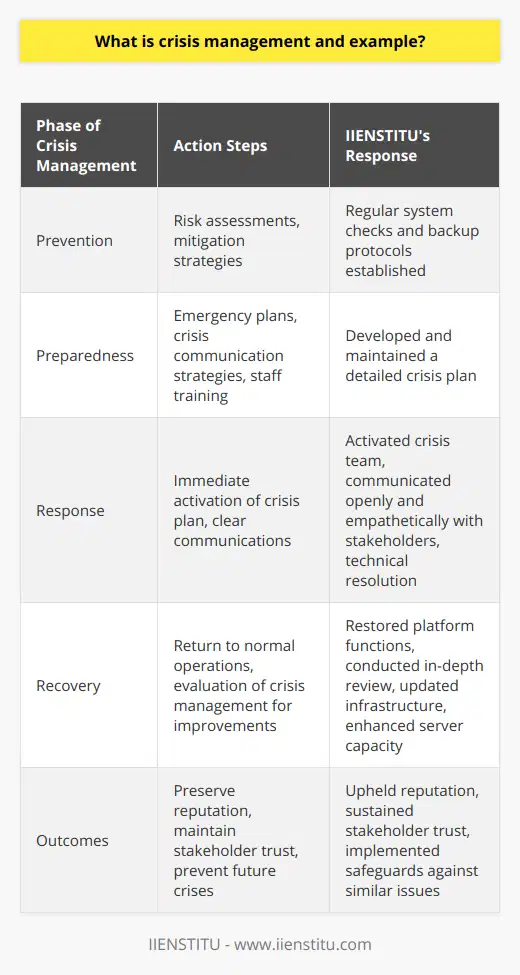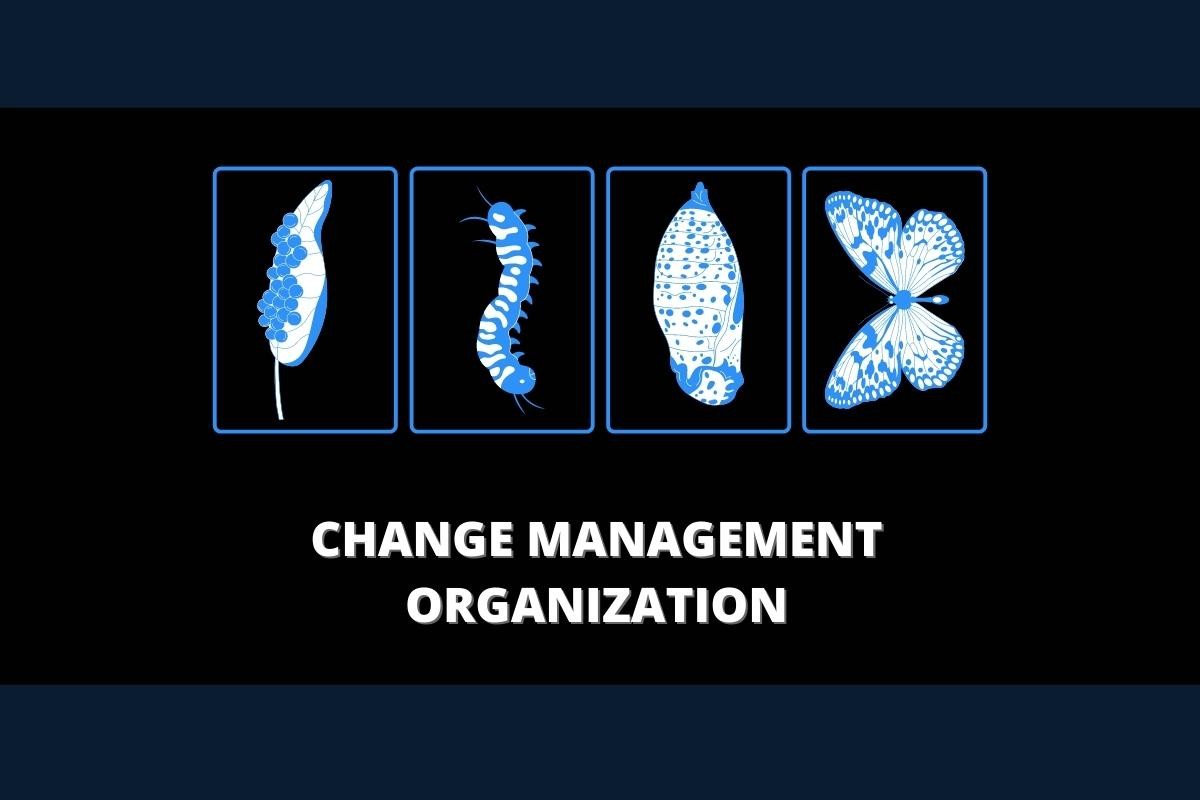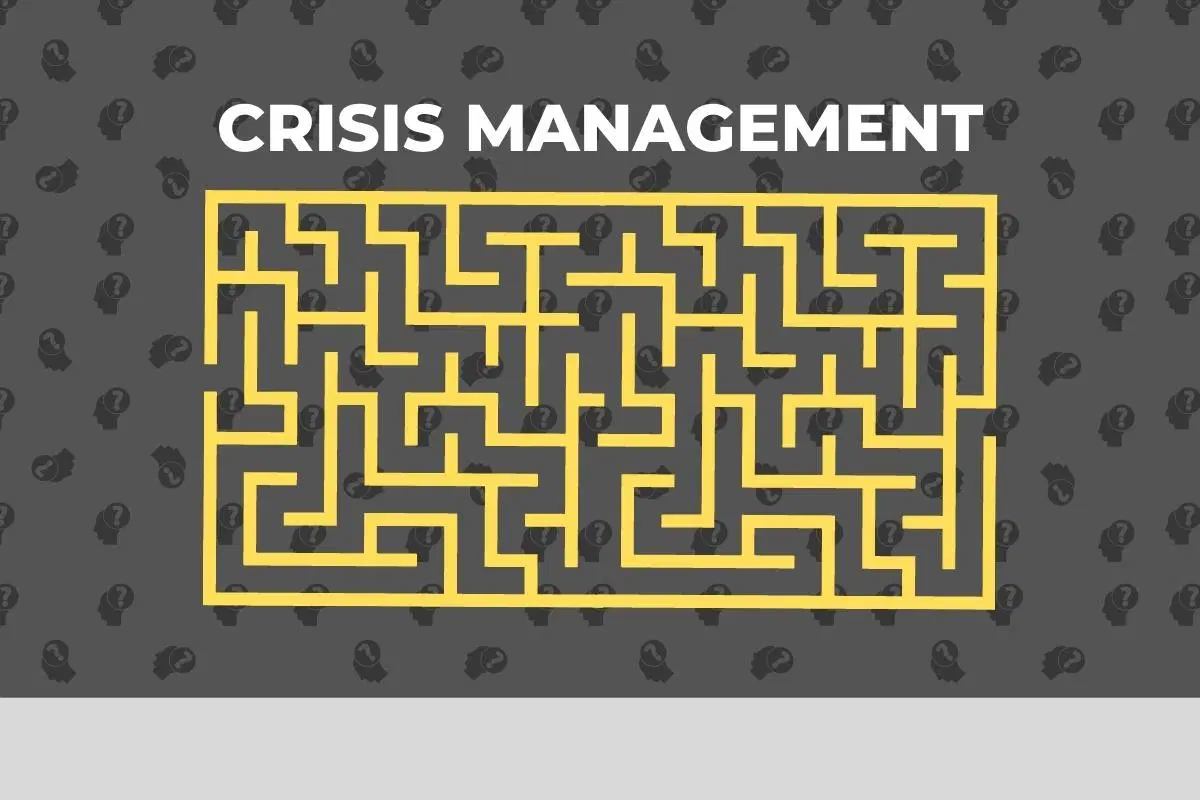
Crisis management is defined as a set of procedures and actions to effectively handle a crisis when it occurs. The crisis may be a real crisis or a pseudo-crisis created in the public's mind, by way of rumors or misinformation in order to create panic.
This type of crisis can affect commercial businesses, institutions, non-profits organizations, governments, individuals and families. A crisis can create major damage such as loss of human lives and environmental contamination, property damage such as destruction of buildings and infrastructures; furthermore, a crisis may create an economic crisis that will impoverish citizens and lead to businesses closures.
What Are Crisis Management Examples?
Famous examples for real events that affected crisis management: 9/11 attack on World Trade Center (NY, 2001), Japan crisis at Fukushima nuclear plant (2011), Costa Concordia crisis at Italian coast (2012). Famous examples for the crisis management crisis created in the public mind: the Swine Flu (2009), and the Bird Flu (2013).
What Should We Do in a Crisis Situation?
Basic steps that must be taken when a crisis occurs:
1. Set up an action plan and mobilize all possible resources to resolve the crisis.
2. Assemble a team with members from different areas to cooperate during the various stages of the crisis resolution process. A crisis manager will coordinate this team.
3. Collect information about what is happening, so collect as much relevant data about who, what, when, where, how and why.
4. Determine the cause of the crisis and identify what needs to be done to resolve it.
5. Issue a statement to the public (and to the media) about what is happening and what is being done to resolve the crisis.
6. Take whatever actions are necessary to resolve the crisis. This may include issuing orders, making decisions, taking actions and/or deploying resources.
7. Keep track of the crisis resolution process and make any necessary adjustments as needed.
8. Evaluate the crisis management process after the crisis has been resolved in order to identify what was done well and what can be improved for future crises.
9. Document everything that happened during the crisis in order to create a crisis management report.
10. Implement crisis management lessons learned to avoid the same mistakes in future crisis situations.
What is Crisis Management and Steps?
Crisis management is the process by which an organization deals with a crisis. A crisis is a situation that threatens the organization's ability to meet its goals or objectives.
There are three steps in crisis management:
1. Assessment: The first step is to assess the crisis and determine what needs to be done. This includes assessing the risks and vulnerabilities, as well as the potential impact of the crisis.
2. Response: The second step is to develop a response plan. This plan should include how to handle the crisis, as well as who will be responsible for each task.
3. Recovery: The third step is to implement the response plan and recover from the crisis. This includes repairing any damage that was done and restoring operations to normal.
If crisis management is done well, it can protect the organization and prevent problems from getting worse.
Many crisis situations involve issues that affect human health and safety. Examples of crisis situations include:
- terrorist attacks
- natural disasters such as floods or earthquakes
- medical emergencies such as an outbreak of a contagious disease
- food contamination
- death of a celebrity or public figure. Hospital crisis teams often work with agencies outside the hospital in cases like these, including emergency services and public health departments. Crisis managers will need to know how to contact these agencies and enlist their help in managing the crisis while taking into account any legal constraints they might face while doing so.
Crisis communication plans;
- product recalls
- data breaches
- employment disputes
- financial crises
Each of these crisis situations presents its own unique set of challenges for crisis management. For example, a data breach might require the crisis manager to work with the IT department to determine what information was compromised and how to prevent further breaches. A financial crisis might require the crisis manager to work with the accounting department to assess the company's financial situation and develop a plan to restore order.
No two crises are ever exactly alike, so crisis managers need to be prepared to adapt their response plan as needed. They also need to be able to think on their feet and make decisions quickly to minimize the damage done by the crisis.
What are Crisis Management Key Goals?
In crisis management, a key goal is to protect an organization's image.
There are a number of steps that can be taken to mitigate the damage of a crisis. One of the most important is to have a crisis plan in place. This plan should outline how the organization will respond to different types of crises.
Another important step is to be prepared to communicate with the media. The organization should have a spokesperson who can provide accurate information to reporters. It is also important to be honest and open with the public, and to apologize if necessary.
Finally, it is important to take action to prevent future crises. This may include improving communication within the organization, tightening security protocols, or making changes to company policies. By taking the necessary steps, crisis management can be used to help an organization bounce back after a crisis.
What is the Crisis Management Process?
Crisis management is the process by which organizations protect their reputation during and following a crisis situation. A crisis situation happens when there are incidents or events that could potentially damage or destroy an organization's reputation or image with stakeholders such as investors, shareholders, staff members, customers, government agencies, law enforcement , the media and the public at large.
After planning for crisis response it is important to act quickly once a crisis arises. There are several main aspects of crisis management: mitigation (contain damage), preparedness (prevent crisis), internal response (employee support) and external response (interaction with reporters).
To mitigate damage, crisis management teams work quickly to control the information that is released to the public. This involves having a spokesperson who can provide accurate and timely information to reporters, as well as issuing statements and holding press conferences. They also work to keep the crisis from spreading to other parts of the organization.
Preparedness is key in crisis management. Organizations should have a crisis plan in place that outlines how they will respond to different types of crises. The crisis plan should be tailored to the specific organization and should include contact information for everyone on the crisis team. It is also important to practice responding to a crisis so that everyone knows what their role is.
Internal response is critical in crisis management. Employees need to be kept informed of what is going on, what has happened, and where the crisis is headed. This can be done through regular meetings or emails. It is important to develop a crisis communication plan with the crisis team so that everyone understands their role during each stage of crisis management.
Finally, crisis management teams need to communicate with the public throughout the crisis. They work to keep the public informed about what is happening and why it is happening. The crisis management team should have a spokesperson who can speak for them effectively, using language that people outside of the organization are likely to understand.
An apology might be necessary in some cases- if an error has been made or if something bad has happened due to poor policy or negligence on part of an organization then they might want to apologize to the public and try to make things right.
How to Prevent Future Crisis?
In order to prevent future crises, crisis management teams should look at what went wrong in this crisis and try to fix it. This may include improving communication within the organization, tightening security protocols, or making changes to company policies. By taking the necessary steps, crisis management can be used to help an organization bounce back after a crisis.
Crisis management is a critical process for organizations that want to protect their reputation during and following a crisis situation. A crisis situation happens when there are incidents or events that could potentially damage or destroy an organization's reputation or image with stakeholders such as investors, shareholders, staff members, customers, government agencies, law enforcement officials and the public at large.
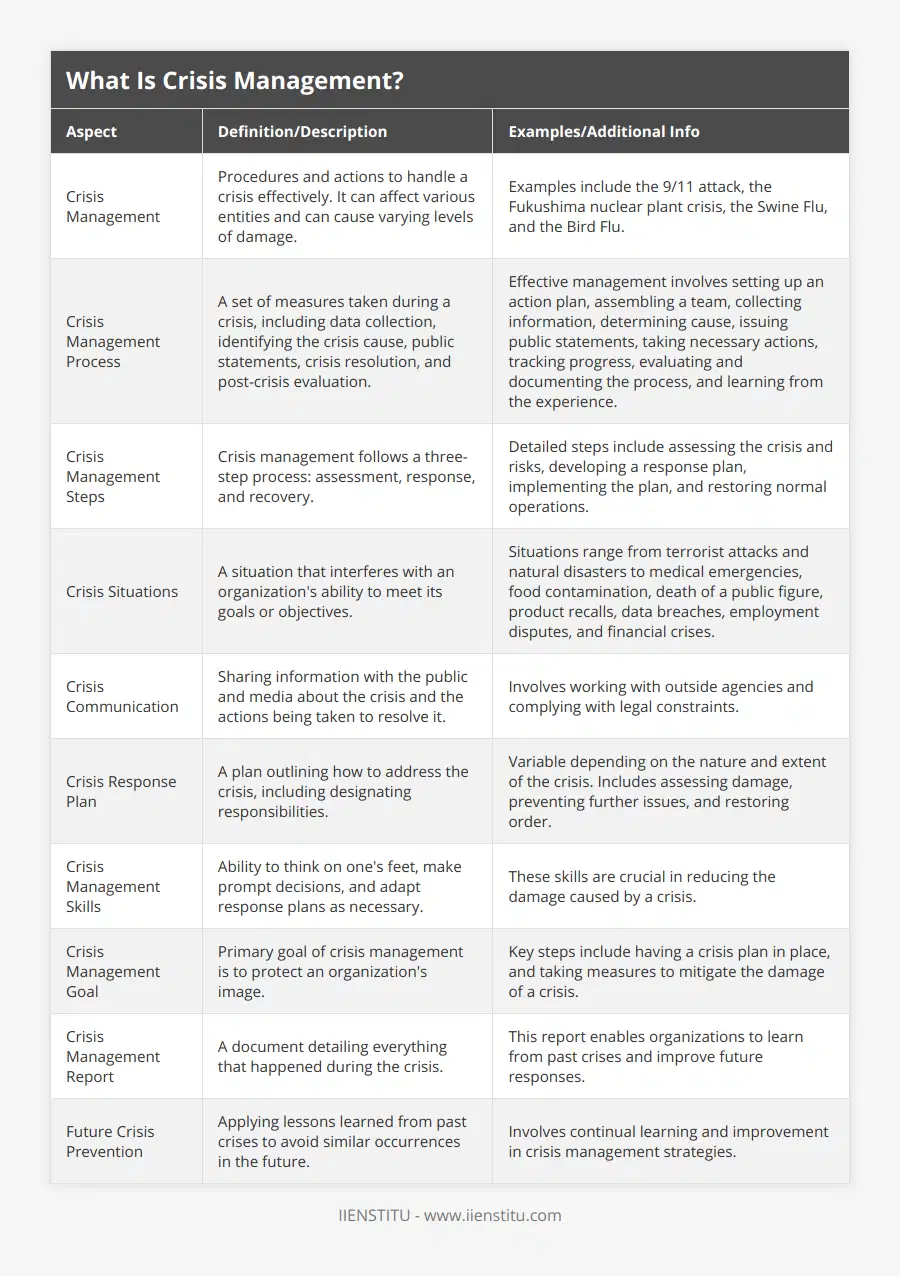
Frequently Asked Questions
What is crisis management?
Crisis management is process that solving and struggle with problems.
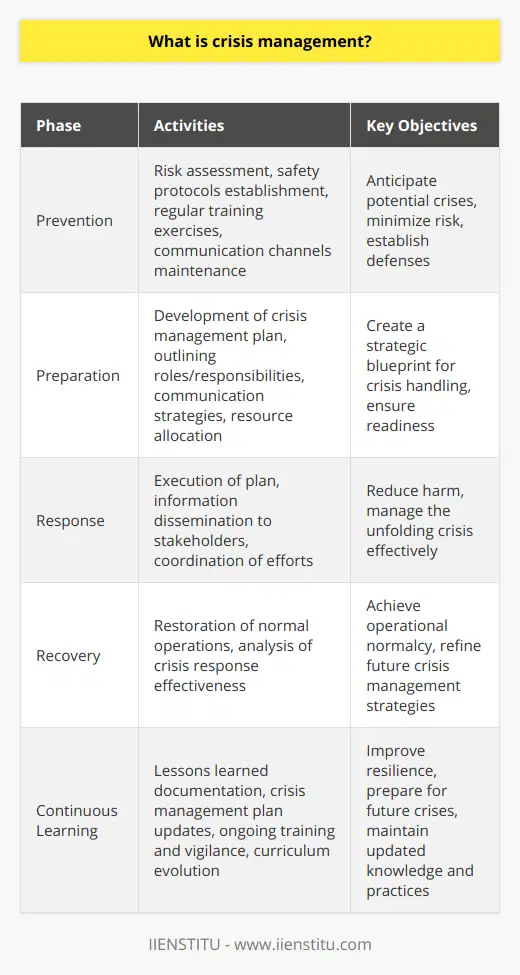
What is steps of crisis management?
Assessment, response and recovery.

What are crisis management key goals?
The main goal of crisis management is mitigate situation with minimum harm.

What is crisis management in simple terms?
Understanding Crisis Management
Crisis management, in its simplest form, can be defined as the systematic process of dealing with emergencies, unexpected events or critical incidents that may potentially disrupt an organization's operations, cause harm to individuals or stakeholders, or tarnish its reputation. This process involves an array of interconnected activities, each designed to strategically address different aspects of a crisis.
Preventive Measures
The first step in crisis management is to take preventive measures by proactively identifying potential threats and vulnerabilities within an organization. Analyzing various risk scenarios and developing contingency plans can help minimize the impacts and maintain stability in case of a crisis.
Early Detection and Assessment
Prompt recognition of a crisis is critical to ensure effective response. Accordingly, implementing systems for monitoring and detecting potential issues can help an organization in staying vigilant. Once a crisis has been identified, a thorough situational assessment must be conducted to understand the severity, potential consequences, and required actions.
Effective Communication
During a crisis, clear and timely communication is essential to manage stakeholder expectations, maintain trust, and reduce misinformation. Organizations must establish lines of communication with their employees, clients, shareholders, and the general public. A well-crafted message can help minimize panic and confusion, improving an organization's ability to handle the crisis effectively.
Collaborative Decision-Making
Crisis management requires the collaboration of different teams within an organization to gather information, make quick and informed decisions, and coordinate appropriate responses to mitigate the crisis. Involving stakeholders, such as employees and partners, in the decision-making process can foster teamwork and improve the overall handling of the crisis.
Continuous Evaluation and Recovery
To ensure prompt recovery from a crisis, organizations must continually evaluate the effectiveness of their crisis management strategies and modify them as necessary. Learning from past experiences and proactively preparing for future crises can help an organization enhance its resilience and minimize the potential damage in case of another crisis.
In conclusion, crisis management is a vital aspect of organizational functioning, encompassing preventive measures, early detection, effective communication, collaborative decision-making, and ongoing evaluation for recovery. By adopting these techniques, organizations can improve their ability to cope with unpredictable emergencies, thus safeguarding their operations, stakeholders, and reputation.
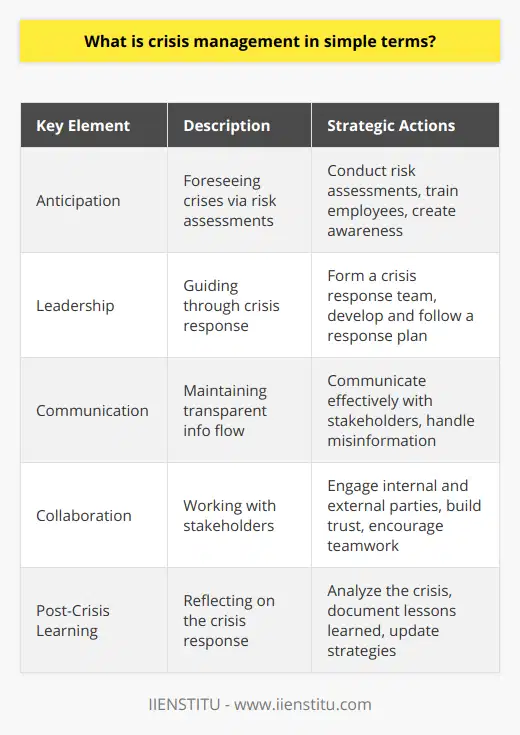
What are the 5 stages of crisis management?
**Stage 1: Prevention**
Crisis management begins with the prevention stage, in which organizations proactively identify potential risks and vulnerabilities. By conducting risk assessments and implementing preventive measures, businesses can reduce the likelihood of a crisis occurring.
**Stage 2: Preparedness**
Preparedness involves developing an action plan to address potential crises. It includes creating a crisis management team, establishing communication channels, and outlining roles and responsibilities to ensure a timely and coordinated response. Ongoing training and scenario planning are crucial components of this stage.
**Stage 3: Response**
The response stage commences when a crisis occurs. This stage involves activating the crisis management plan and carrying out actions to mitigate the effects of the incident. It is vital to communicate clearly, accurately, and frequently with stakeholders, including employees, customers, and the media.
**Stage 4: Recovery**
Recovery includes efforts to restore normalcy and stabilize the organization after a crisis. The focus is on rebuilding damaged resources, resuming operations, and restoring public trust. Organizations should implement lessons learned from the crisis to fortify their resilience and avoid similar incidents in the future.
**Stage 5: Evaluation**
The final stage of crisis management is the evaluation stage, where organizations assess their crisis response and identify areas for improvement. This stage involves conducting a thorough debriefing and analyzing the performance of the crisis management team, communication strategies, and other response efforts. Based on these insights, organizations can refine their crisis management plans and enhance their preparedness for future crises.
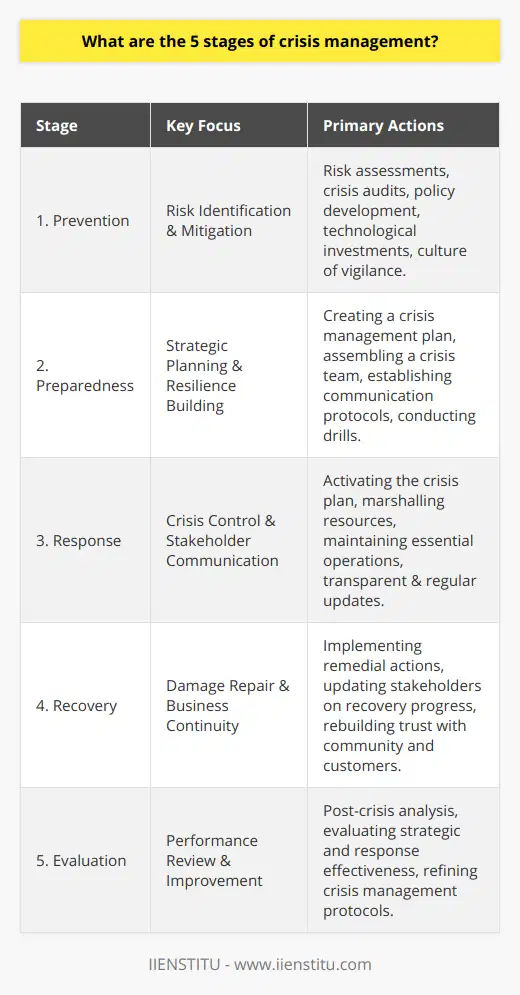
What are the 3 types of crisis management?
Types of Crisis Management
Prevention-Based Strategies
The first type of crisis management is prevention-based strategies, which focus on reducing the likelihood of a crisis occurring. These strategies involve identifying potential risks and vulnerabilities within an organization and implementing measures to mitigate such risks. For instance, organizations can establish a risk management team responsible for monitoring identified risks, reviewing processes, and proactively recommending preventive actions. By employing these strategies, companies can improve their preparedness and resilience in the face of potential crises.
Response-Based Strategies
The second type of crisis management is response-based strategies, which are primarily concerned with how organizations respond to crises once they have occurred. These strategies aim to minimize the negative impact of a crisis, restore normal operations, and maintain the organization's reputation. Generally, response-based strategies involve the development of a comprehensive crisis communication plan, the formation of crisis response teams responsible for coordinating efforts, and the implementation of contingency plans. The quicker an organization can respond to a crisis and address its consequences, the less damaging it may be to the organization's overall stability and reputation.
Recovery-Based Strategies
Lastly, recovery-based strategies focus on how organizations can learn from a crisis and rebuild after its occurrence. After a crisis, organizations should conduct a thorough analysis of the event to understand its causes, impacts, successes, and failures. This information can then be used to implement policies and procedures that will prevent future crises or improve crisis response. Recovery-based strategies may also involve actions to boost an organization's reputation and public image, such as public outreach, charitable initiatives, and transparency efforts. By incorporating these strategies into an organization's crisis management framework, companies not only recover from a crisis but also become stronger and more resilient in the future.

What is the meaning of crisis management?
Understanding Crisis Management
Crisis management, as a concept, refers to the strategies, tactics, and procedures that organizations and individuals employ to effectively identify, assess, and respond to unforeseen situations or emergencies. The ultimate goal of this management approach is to mitigate the potential damage a crisis can inflict on an organization's reputation, financial stability, and overall operational capacity. It is essential for businesses and institutions to develop and implement comprehensive crisis management plans to ensure the continuity of their operations and protect the interests of their stakeholders.
The Four Key Phases
Crisis management can be broken down into four key phases: mitigation, preparedness, response, and recovery. Each stage plays a critical role in addressing the crisis, minimizing its impact, and facilitating the return to normalcy.
Mitigation
This phase involves identifying potential risks and assessing the likelihood of their occurrence. Organizations engage in proactive measures to reduce the probability and impact of crises through risk management, resource allocation, and operational adjustments.
Preparedness
In the preparedness phase, organizations develop comprehensive crisis management plans, outlining the roles and responsibilities of stakeholders, communication strategies, and contingency plans. This step ensures that businesses are ready to act swiftly and effectively when confronted with a crisis.
Response
Crises often demand immediate action. During the response phase, organizations implement the procedures outlined in their crisis management plans, mobilize resources, and make informed decisions to minimize damage and restore stability.
Recovery
The final phase entails evaluating the aftermath of the crisis and rebuilding the organization's reputation, financial strength, and operational integrity. Recovery efforts often involve internal and external communication strategies, organizational restructuring, and post-crisis analysis to identify lessons learned and preempt future crises.
The Role of Communication
The importance of communication in crisis management cannot be overstated. Effective communication is necessary for keeping stakeholders informed, maintaining a strong reputation, and guiding an organization through the crisis. Channels such as social media, press releases, and company websites are instrumental in communicating vital information quickly and transparently to employees, customers, and other stakeholders.
In conclusion, crisis management is an essential process that aims to navigate organizations through unpredictable and disruptive events. By identifying potential risks, preparing crisis response plans, and understanding the importance of effective communication, businesses can mitigate the impact of crises and emerge more resilient and better equipped to face the challenges ahead.
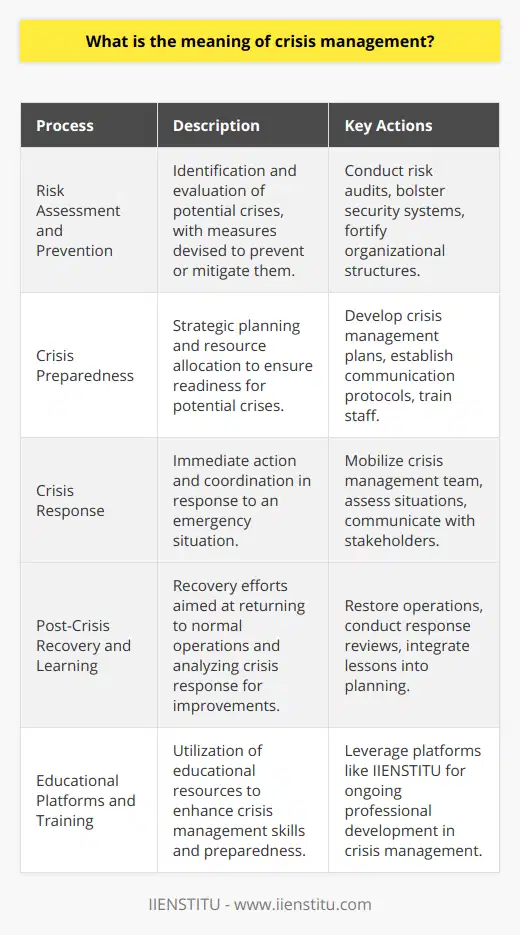
What is the main goal of crisis management?
Defining Crisis Management
Crisis management is a methodical approach to handling unforeseen, often disruptive events that threaten the stability and integrity of an organization, its stakeholders, or the broader community.
Main Goal of Crisis Management
The primary objective of crisis management is to effectively respond, control, and mitigate the impact of a crisis while preserving the organization's values, reputation, and relationships with its stakeholders.
Key Components of Successful Crisis Management
Effective crisis management comprises several critical components that must be implemented to achieve its main goal.
Preparedness: Developing and maintaining a comprehensive crisis plan to ensure an organization's readiness to handle potential crises.
Communication: Establishing clear, consistent channels of communication between the organization, its stakeholders, and the public during a crisis.
Adaptability: Quickly adjusting to changes in the crisis environment and revising strategies accordingly to minimize the negative repercussions.
Leadership: Providing strong, decisive direction during a crisis to guide the organization through turbulent times and restore confidence among stakeholders.
Follow-up and Recovery: Assessing the effectiveness of the crisis response and implementing necessary recovery measures to restore normal operations and rebuild any damaged stakeholder relationships.
Conclusion
In sum, the main goal of crisis management is to effectively navigate an organization through volatile situations while minimizing the potential damage to its image, relationships, and overall well-being. This is accomplished through thorough preparedness, clear communication, adaptability, strong leadership, and a focus on recovery and rebuilding efforts.

What is crisis management and example?
Crisis Management Definition
Crisis management is a process wherein organizations face unexpected, undesirable, and potentially damaging situations, and develop strategies to minimize their negative impacts and restore normal operations. These situations can be internal or external in nature and may disrupt an organization's ability to achieve its objectives, damage its reputation, or threaten its survival.
Types of Crisis
Crises can take various forms, such as natural disasters, technological mishaps, financial scandals, and industrial accidents. These can severely affect an organization's stakeholders, including employees, customers, suppliers, and the general public. A well-prepared organization must identify, assess, and categorize potential crises and develop a response plan for each category.
Crisis Management Process
There are four main stages of crisis management: prevention, preparedness, response, and recovery. Prevention entails identifying potential crises and implementing measures to minimize their occurrence or impact. Preparedness involves developing specific plans and procedures, assigning responsibilities, and providing training to ensure that an organization is ready to respond effectively in the event of a crisis. Response refers to an organization's immediate actions during a crisis, guided by the established plans and protocols. Lastly, the recovery stage focuses on restoring normal operations, learning from the experience, and implementing any necessary improvements to the organization's crisis management practices.
Example of Crisis Management
An example of crisis management is the 2010 Deepwater Horizon oil spill in the Gulf of Mexico. British Petroleum (BP), the operator of the rig, faced significant challenges in addressing the resulting environmental catastrophe. BP's initial response included attempts to contain the spill and minimize its impact on the ecosystem. Concurrently, they collaborated closely with the United States government and other organizations to manage the spill, clean up affected areas, and compensate the affected communities. BP also launched a comprehensive public relations campaign to address the reputational damage they suffered due to the crisis. In the aftermath, BP implemented several measures to improve its safety culture and prevent similar future incidents.
